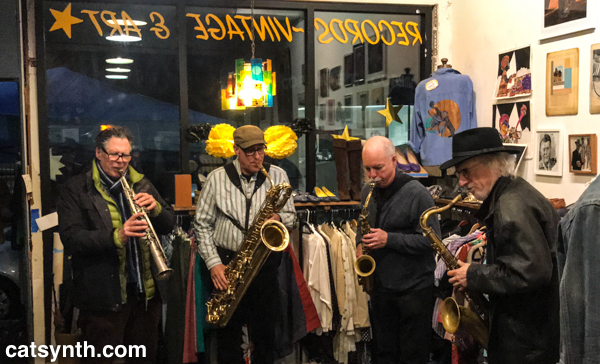We finally catch up on the remaining show report in our backlog: the Hardly Strictly Personal 2017 Festival that took place at the Finnish Kaleva Hall in Berkeley about two months ago. We will be presenting it out of order, with Day 3 first. This day featured my band CDP (Census Designated Place) among many other artists.

We had our full four-member lineup for this event, including myself, Tom Djll on synthesizers, Joshua Marshall on saxophones, and Mark Pino on drums. We played three tunes with extended improvisation sections. The energy on stage was great, and the music just seemed to flow. This was the band and style of performance I always wanted. You can here a bit in these two videos, featuring our tunes White Wine and North Berkeley BART.
CDP Playing White Wine at Finnish Kaleva Hall from CatSynth on Vimeo.
CDP "Playing North Berkeley BART" at Finnish Kaleva Hall from CatSynth on Vimeo.
Mark and I form the rhythm section, where I lay down vamps over his solid drums. The interplay of Tom and Josh on melody and open solos wasn’t planned per se, but adds a lot to the sound of the group. We got a great reception from the audience, and definitely looked forward to our future shows.
The evening opened with Alphastare performing a solo electronic set.

There were a lot of interesting timbres that I liked, some quite thick and noisy, that were woven into a narrative.
We were on second, and then followed by United Separatists, featuring Drew Wheeler on guitar and Timothy Orr on drums.

The instrumentation can sometimes be treacherous in an experimental-music setting, but I like what I’ve heard from this duo whenever I have heard them. There is phrasing, punctuation and space that gives it a captivating feel. Sometimes Orr’s drums are the melodic instrument and Wheeler’s guitar is the percussion. This photo of Wheeler framed by Moog Theremini (not mine) and a water phone was a fun coincidence.

Next up was ebolabuddha with their unique combination of black metal and improvised literary readings.

In addition to the musicians on stage, including Eli Pontecorvo on bass, Mark Pino on drums, Plague, Tom Weeks, Lorenzo Arreguin and Steve Jong, there always a wide selection of books scattered about. Members of the band read from them at various points, but the audience is encouraged to participate as well.
An ebolabuddha performance is always an intense experience but it was even more so in the Finnish Hall with its delightfully bizarre acoustics and the friendly audience. Here is Mark having a quintessential “ebolabuddha moment.”

They were followed by Double-A Posture Palace , a trio featuring Andrew Barnes Jamieson on keyboard and voice, Joshua Marshall returning on saxophones, and Aaron Levin on drums.

It was a quieter set (especially in comparison to what preceded it), but the gentle piano sounds in the opening belied the extremely clever and snarky nature of what was unfolding, as Jamieson sang an ode to performing experimental music that simultaneously celebrated it and pointed out some of the musical shortcomings that many of us discuss only privately. It was truly funny and ingenious, and I congratulate all three members of the set on this performance.
The final set of the evening, and of the festival as a whole, featured the latest incarnation of Instagon is an ever changing set of musicians, never the same. For this version, project creator Lob was joined by Rent Romus on saxophone, Hannah Glass on violin, Leland Vandermuelen on guitar, and Mark Pino on drums – Mark once again demonstrating why I refer to him as the “hardest working man in the new music scene.”

Overall the third day of the festival went well and showcased a variety of music. I am glad that CDP played early so I could relax and enjoy the sense of accomplishment while listening to the subsequent sets. The festival is a fundraiser for EarthJustice and the Homeless Action Center, both fine causes that many of us stage are proud to support. I would also like to give a special thanks to Mika Pontecorvo for organizing the event, and to Eli Pontecorvo, Kersti Abrams, Rent Romus and others who worked hard to make it happen.
















